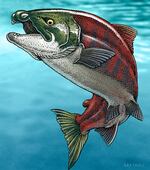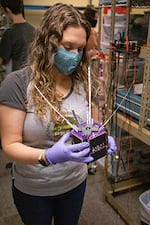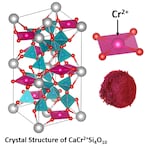
This illustration by Ray Troll depicts Oncorhynchus rastrosus. The researchers believe that their tusk-like teeth were useful when they swam upstream to spawn.
Courtesy Ray Troll/University of Oregon
The amazing giant tusked salmon
Salmon have lived in the Pacific Northwest for millions of years. But the salmon that live today are a far cry from the Oncorhynchus rastrosus, a giant salmon relative from around 5 million years ago. The salmon’s fossilized remains were found in Jefferson County, Oregon and first described in 1972. The fish could grow to over 8 feet long and were filter feeders, like modern day kokanee.
One thing that set the giant fish apart from other salmon was the presence of large projecting teeth. Initially, the teeth were compared to those of a saber-toothed cat. But now, with new fossil discoveries and modern technology, scientists from the University of Oregon and Oregon State University are revising that description.
Instead of pointing down and inward, the scientists found that the large teeth projected outward, like the tusks of a warthog. The scientists hypothesize the tusks were used to excavate nests (redds) and defend against predators and rival salmon.
The results were published in the PLOS ONE here.
“— “Smilodonichthys rastrosus: A new pliocene salmonid fish from Western States” Bulletin No. 18 of the (University of Oregon) Museum of Natural History, 1972.Named Smilodonichthys, from the fossil genus of sabre-toothed cat, in reference to the pair of large teeth at the anterior end of the upper jaw, and rastrosus, from the Latin word for raker, in reference to the numerous gill rakers.”
New malaria vaccine ready for human trials
Despite more than a century of effort to stop its spread, malaria is one of those diseases that have just stuck around, especially in the Southern Hemisphere. In fact, an estimated three out of every 100 people on the planet had malaria in 2022. More than a half million people died of the disease, most of them children.
Efforts to create a vaccine have been difficult, in part, because malaria is caused by parasites, which have complex life cycles and genetics. Only two vaccines have been approved by the World Health Organization for use — one in 2021 and another last year.
Now researchers in the Pacific Northwest hope to add another option to the mix. A team at Seattle Children’s Research Institute and Sanaria are getting ready to start human trials of a new vaccine, PfSPZ-LARC2, that uses genetically modified malaria parasites to elicit an immune response.
After a person is bitten by a malaria parasite-infected mosquito, the parasites move into the liver, where they multiply before entering the bloodstream, triggering malaria symptoms. In the vaccine, the parasites are modified to shut down right before they transition into the blood. They live just long enough to train your immune system to attack.
The new vaccine has proven successful in animals and now will enter the human trial phase to test for safety and effectiveness.
Read more in EMBO Molecular Medicine here.
Taking the fat out of pizza (boxes)
Despite the wishful thinking of countless pizza lovers, those greasy pizza boxes shouldn’t go in your recycling bin. It’s really difficult to separate out all that oil (though there is some disagreement over whether that matters). Some places, like Portland, have gotten around this by allowing pizza boxes to be composted. But only 3% of Americans have access to municipal curbside compost collection.
Researchers at Idaho National Lab are working on this oily problem — and the solution they’ve found could have applications far beyond household recycling. The team has developed a system that uses the common solvent dimethyl ether to draw fats, oils and greases out of the cardboard, where they collect and coagulate into a removable form. The solvent is pumped out and can be reused.
The research, funded by the U.S. Department of Defense, is part of a larger effort to figure out ways to repurpose military waste. The ultimate goal is to be able to break down plastics, batteries and other disposables into materials that could be used in other applications, and reduce the need for potentially dangerous supply runs.
The paper in the Journal of Cleaner Production can be read here.

Portland State University student Catie Spivey holds a model of OreSat0 in 2021. The group's second satellite is scheduled for launch in July 2024.
Courtesy PSU/Patric Simon
Oregon-grown satellite launch
There are more than 10,000 satellites orbiting the Earth right now, most of them in low orbit. One of them is the OreSat0, a small satellite (about twice the size of a Rubik’s Cube) built by the Portland State Aerospace Society. It launched in 2022 and is expected to burn up in the atmosphere sometime in the next couple years.
Now the student group at Portland State University is launching a second satellite,OreSat0.5, into orbit. They will be testing new flight systems the group has been developing over the past few years. The new satellite is about twice the size of the first one, and it’s currently scheduled to launch from California in July on a SpaceX rocket.
The group is building towards launching a final version of the satellite as part of NASA’s CubeSat Launch Initiative in 2025. The goal of that satellite is to provide opportunities for K-12 science students from around the state to access the satellite and interact with the technology on board.

This photo released by Oregon State University shows a marbled murrelet nesting on moss in a coastal forest.
Courtesy of Brett Lovelace/OSU
Tracking rare birds with artificial intelligence
Marbled murrelets don’t like human company. The rare and threatened birds spend a lot of time foraging in the ocean. But when it’s time to breed in Oregon and Washington, they travel up to 50 miles inland to lay eggs in old growth trees.
But those nests are often high up in the canopy in difficult-to-access areas, and they’re generally hard to locate. This means it can be challenging for scientists to know how the birds are faring — and if their numbers continue to decline because of habitat loss and other factors.
But now, researchers at Oregon State University and the U.S. Forest Service’s Pacific Northwest Research Station have developed an AI system that can recognize the birds based on sound recordings out in the field. The scientists used hundreds of thousands of hours of acoustic data from thousands of locations in the Oregon Coast Range and the Olympic Peninsula to train the AI to recognize the call of the murrelets. The AI was able to pick out a murrelet call with greater than 90% accuracy.
The researchers will continue to refine the tool. They say it would be far less labor- and time-intensive to to use AI instead of humans to monitor the birds.
This research was published in the journal Ecological Indicators here.
OPB Science Update: Creating new colors
Back in 2020, OPB featured a story about an Oregon State University scientist whose focus was creating new, safer, and better-performing color pigments for use in paints. Chemist Mas Subramanian and his students discovered YInMn (pronounced yin-min) blue by accident in 2009, but since then they have been actively looking for the next color breakthrough.
Now his lab has developed a series of new chromium-based red and magenta pigments. The researchers say the new pigments promise better durability, safety, and heat reflectivity than most current red pigments in use.

This graphic released by Oregon State University shows the new magenta pigment and its crystal structure.
Courtesy OSU
In this monthly rundown from OPB, “All Science. No Fiction.” creator Jes Burns features the most interesting, wondrous and hopeful science coming out of the Pacific Northwest.
And remember: Science builds on the science that came before. No one study tells the whole story.
Updated on June 27: The launch date for the PSU satellite has been pushed back yet again. The story has been updated to include a link to the latest launch window schedule.




